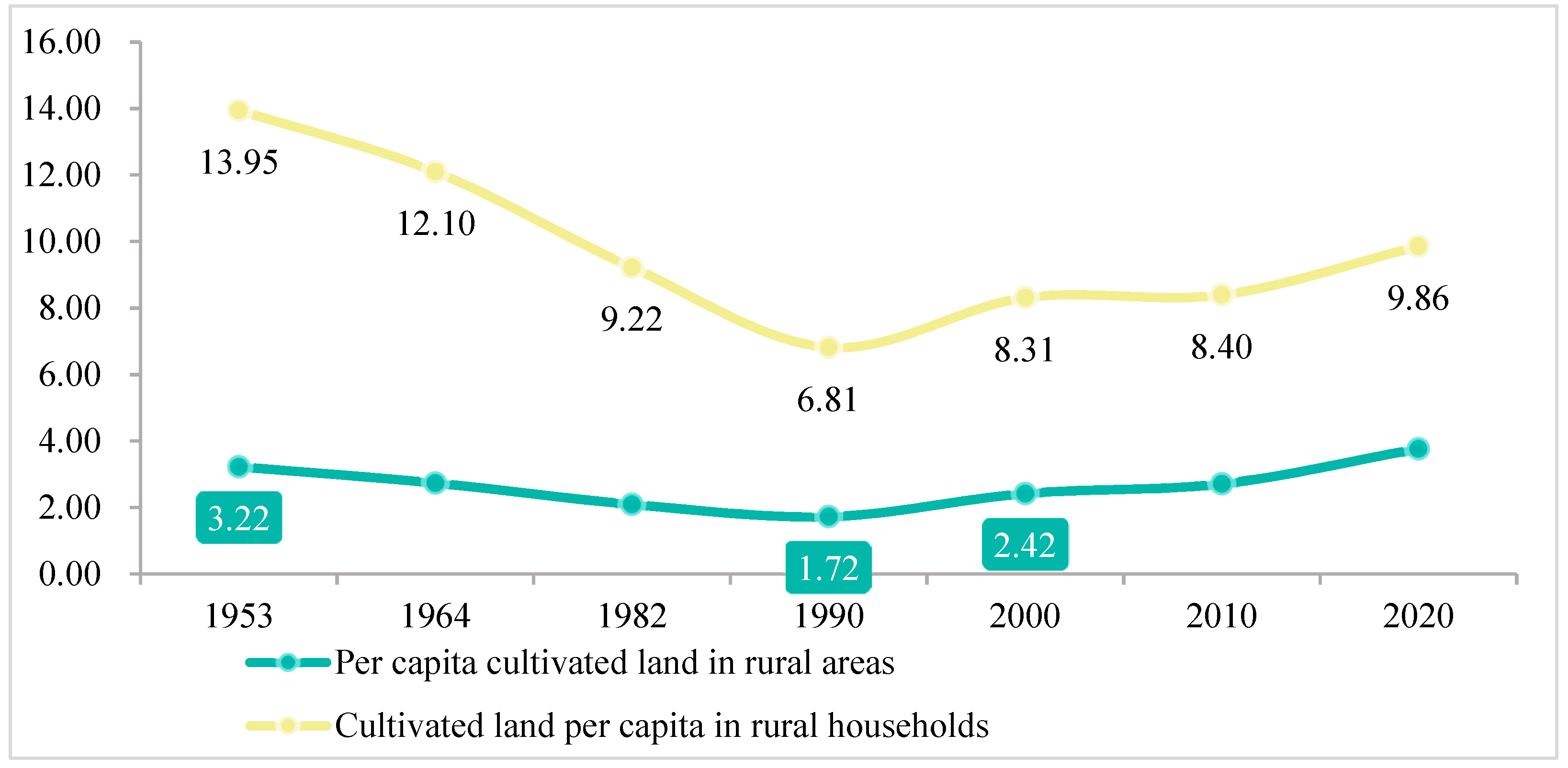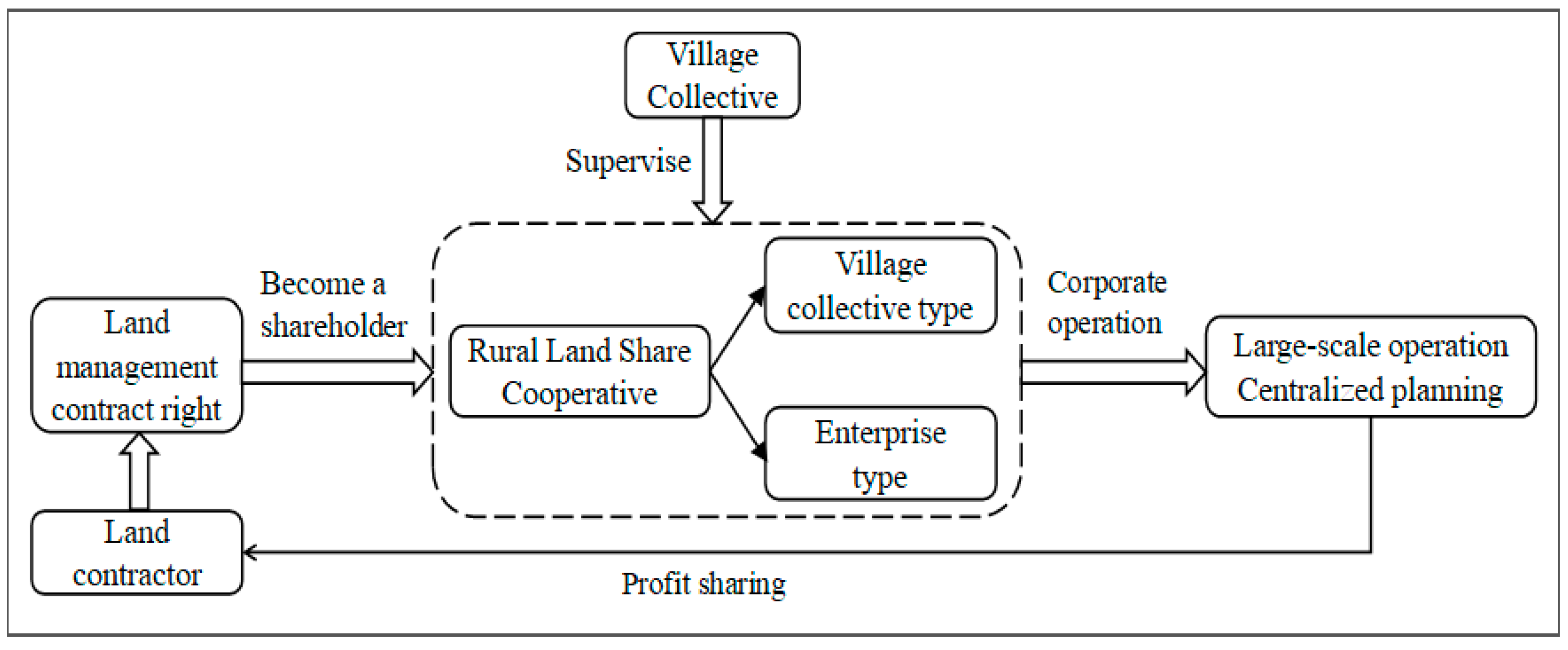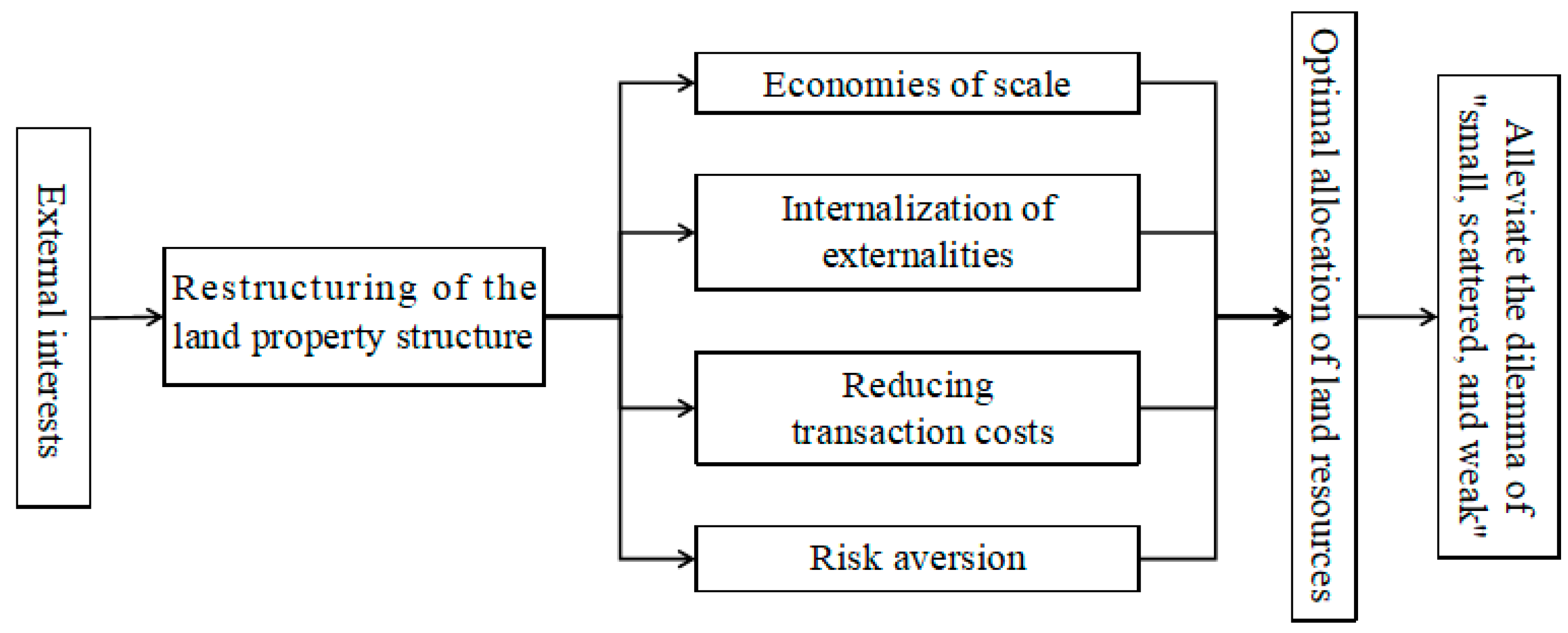A Rural Land Share Cooperative System for Alleviating the Small, Scattered, and Weak Dilemma in Agricultural Development: The Cases of Tangyue, Zhouchong, and Chongzhou
Abstract
1. Introduction
2. Theoretical Background
3. Methodology
4. Solutions to “Small, Scattered, and Weak” Dilemma in Agricultural Development
4.1. Village Collective-Led Model in Tangyue
4.2. Village and Enterprise Integration Model in Zhouchong
4.3. Multi-Entity Joint Management Model in Chongzhou
5. Results
6. Discussion
6.1. Similarities and Differences between the Cases Examined and World Projects: Other Models?
6.2. How Did These Methods Contribute to Efficiency and Fairness
7. Conclusions and Limitations
7.1. Conclusions
7.2. Limitations
Author Contributions
Funding
Institutional Review Board Statement
Data Availability Statement
Conflicts of Interest
References
- Hartvigsen, M. Land reform and land fragmentation in Central and Eastern Europe. Land Use Policy 2014, 36, 330–341. [Google Scholar] [CrossRef]
- Muyombano, E.; Espling, M. Land use consolidation in Rwanda: The experiences of small-scale farmers in Musanze District, Northern Province. Land Use Policy 2020, 99, 105060. [Google Scholar] [CrossRef]
- Chen, L. Significance of cultivation of new agricultural management subjects for the development goal of modern agriculture: A perspective review. IOP Conf. Ser. Earth Environ. Sci. 2018, 185, 12030. [Google Scholar] [CrossRef]
- Bizoza, A.R. Investigating the effectiveness of land use consolidation–a component of the crop intensification programme in Rwanda. J. Rural. Stud. 2021, 87, 213–225. [Google Scholar] [CrossRef]
- Chaudhar, N.; Minampati, V.R.R. Influence of Dairy co-operatives in Rural Development in India: A case study of Banas Dairy, Banaskantha district, Gujarat. J. Contemp. Issues Bus. Gov. 2021, 27, 1132. [Google Scholar] [CrossRef]
- Meza, I.; Rezaei, E.; Siebert, S.; Ghazaryan, G.; Nouri, H.; Dubovyk, O.; Gerdener, H.; Herbert, C.; Kusche, J.; Popat, E.; et al. Drought risk for agricultural systems in South Africa: Drivers, spatial patterns, and implications for drought risk management. Sci. Total Environ. 2021, 799, 149505. [Google Scholar] [CrossRef] [PubMed]
- Welteji, D. A critical review of rural development policy of Ethiopia: Access, utilization and coverage. Agric. Food Secur. 2018, 7, 55. [Google Scholar] [CrossRef]
- Neda, P.A.; Marija, A.; Scaron; Tefan, B. Agricultural land markets and land leasing in the Republic of Macedonia. Afr. J. Agric. Res. 2012, 7, 2729–2740. [Google Scholar] [CrossRef]
- Paez, D. Marriage of Opposites: Strategies for Public and Private Sectors Working Together in Land Tenure Reform Projects That Support SDGs. Sustain. Dev. Goals Connect. Dilemma 2019, 45–63. [Google Scholar] [CrossRef]
- Xie, H.; Lu, H. Impact of land fragmentation and non-agricultural labor supply on circulation of agricultural land management rights. Land Use Policy 2017, 68, 355–364. [Google Scholar] [CrossRef]
- Lai, Z.; Chen, M.; Liu, T. Changes in and prospects for cultivated land use since the reform and opening up in China. Land Use Policy 2020, 97, 104781. [Google Scholar] [CrossRef]
- Wiggins, S.; Kirsten, J.; Llambí, L. The future of small farms. World Dev. 2010, 38, 1341–1348. [Google Scholar] [CrossRef]
- Pan, Q. Dilemma and Path Selection of the Integration Development of Small Farmers and Modern Agriculture in China. Financ. Eng. Risk Manag. 2020, 3, 66–70. [Google Scholar]
- Matunhu, J. A critique of modernization and dependency theories in Africa: Critical assessment. Afr. J. Hist. Cult. 2011, 3, 65–72. [Google Scholar]
- Varga, M. ‘Subsistence’Readings: World Bank and state approaches to commercialising agriculture in post-communist Eurasia. J. Dev. Stud. 2019, 55, 1253–1266. [Google Scholar] [CrossRef]
- Rajendran, K.; Mohanty, S. Dairy co-operatives and milk marketing in India: Constraints and opportunities. J. Food Distrib. Res. 2004, 35, 34–41. [Google Scholar] [CrossRef]
- Muimba-Kankolongo, A. Food Crop Production by Smallholder Farmers in Southern Africa: Challenges and Opportunities for Improvement; Academic Press: London, UK, 2018. [Google Scholar] [CrossRef]
- Li, F.; Zhao, W.; Yeh, E.T. The locally managed agrarian transition in China: Land shareholding cooperatives and the agricultural co-management system in Chongzhou, Sichuan. Eurasian Geogr. Econ. 2022, 64, 732–757. [Google Scholar] [CrossRef]
- Gong, Y.; Tan, R. Emergence of local collective action for land adjustment in land consolidation in China: An archetype analysis. Landsc. Urban Plan 2021, 214, 104160. [Google Scholar] [CrossRef]
- Fuglie, K.O.; Toole, A.A. The evolving institutional structure of public and private agricultural research. Am. J. Agr. Econ. 2014, 96, 862–883. [Google Scholar] [CrossRef]
- Cortner, O.; Garrett, R.D.; Valentim, J.F.; Ferreira, J.; Niles, M.T.; Reis, J.; Gil, J. Perceptions of integrated crop-livestock systems for sustainable intensification in the Brazilian Amazon. Land Use Policy 2019, 82, 841–853. [Google Scholar] [CrossRef]
- Maclachlan, P.L.; Shimizu, K. Betting on the Farm. In Betting on the Farm; Cornell University Press: Ithaca, NY, USA, 2022. [Google Scholar] [CrossRef]
- Shen, M.; Shen, J. Evaluating the cooperative and family farm programs in China: A rural governance perspective. Land Use Policy 2018, 79, 240–250. [Google Scholar] [CrossRef]
- Giagnocavo, C.; Headquarters, U. The Almería Agricultural Cooperative Model: Creating successful economic and social communities. In The Role of Cooperatives in Poverty Eradication. For United Nations, Division for Social Policy and Development, Department of Economic and Social Affairs. International Year of Cooperatives Side-Event with the Commission for Social Development; UN Headquarters: New York, NY, USA, 2012; p. 1. [Google Scholar]
- Huang, Q.; Li, M.; Chen, Z.; Li, F. Land consolidation: An approach for sustainable development in rural China. Ambio 2011, 40, 93–95. [Google Scholar] [CrossRef]
- Long, H. Land consolidation: An indispensable way of spatial restructuring in rural China. J. Geogr. Sci. 2014, 24, 211–225. [Google Scholar] [CrossRef]
- Zhang, Z.; Zhao, W.; Gu, X. Changes resulting from a land consolidation project (LCP) and its resource–environment effects: A case study in Tianmen City of Hubei Province, China. Land Use Policy 2014, 40, 74–82. [Google Scholar] [CrossRef]
- Asiama, K.O.; Voss, W.; Bennett, R.; Rubanje, I. Land consolidation activities in Sub-Saharan Africa towards the agenda 2030: A tale of three countries. Land Use Policy 2021, 101, 105140. [Google Scholar] [CrossRef]
- Munnangi, A.K.; Lohani, B.; Misra, S.C. A review of land consolidation in the state of Uttar Pradesh, India: Qualitative approach. Land Use Policy 2020, 90, 104309. [Google Scholar] [CrossRef]
- Yin, Q.; Sui, X.; Ye, B.; Zhou, Y.; Li, C.; Zou, M.; Zhou, S. What role does land consolidation play in the multi-dimensional rural revitalization in China? A research synthesis. Land Use Policy 2022, 120, 106261. [Google Scholar] [CrossRef]
- Muhinda, J.M.; Dusengemungu, L. Farm Land Use Consolidation—A Home Grown Solution for Food Security in Rwanda; Rwanda Agricultural Board, Ministry of Agriculture and Animal Husbandry: Kigali, Rwanda, 2013. [Google Scholar]
- Asiama, K.O.; Bennett, R.M.; Zevenbergen, J.A. Land consolidation on Ghana's rural customary lands: Drawing from The Dutch, Lithuanian and Rwandan experiences. J. Rural. Stud. 2017, 56, 87–99. [Google Scholar] [CrossRef]
- Zhao, Y. Rethinking China's land tenure reform: The emergence of farmers' land shareholding cooperatives. Land Tenure J. 2012, 2, 95–117. [Google Scholar]
- Ye, J. Land Transfer and the Pursuit of Agricultural Modernization in C hina. J. Agrar. Change 2015, 15, 314–337. [Google Scholar] [CrossRef]
- Liu, Y.; Li, J.; Yang, Y. Strategic adjustment of land use policy under the economic transformation. Land Use Policy 2018, 74, 5–14. [Google Scholar] [CrossRef]
- Zhao, Y. China's Disappearing Countryside: Towards Sustainable Land Governance for the Poor; Routledge: London, UK, 2016. [Google Scholar]
- Deng, H.; Wang, W. Analysis of the nature and reality of cooperatives: Are there real farmer cooperatives in China. China Rural. Econ. 2014, 7, 15–38. [Google Scholar] [CrossRef]
- Xiandong, L.; Ying, H.; Xianmei, L.; Sinuo, L.; Qiao, M.; Jianzhong, G. Review of China's rural land management system reform: 1949–2019. Environ. Earth Sci. 2022, 81, 369. [Google Scholar] [CrossRef]
- Wang, Q.; Zhang, X. Three rights separation: China’s proposed rural land rights reform and four types of local trials. Land Use Policy 2017, 63, 111–121. [Google Scholar] [CrossRef]
- Chen, A. The politics of the shareholding collective economy in China's rural villages. J. Peasant. Stud. 2016, 43, 828–849. [Google Scholar] [CrossRef]
- Ma, S.; Gong, Y.; Li, D. Reform of the shareholding system for collective assets, residents' participation, and community debts risk. China Econ. Rev. 2019, 58, 101296. [Google Scholar] [CrossRef]
- Zhang, J.; He, C.; Chen, L.; Cao, S. Improving food security in China by taking advantage of marginal and degraded lands. J. Clean. Prod. 2018, 171, 1020–1030. [Google Scholar] [CrossRef]
- Li, L.; Tan, R.; Wu, C. Reconstruction of China’s Farmland Rights System Based on the ‘Trifurcation of Land Rights’ Reform. Land 2020, 9, 51. [Google Scholar] [CrossRef]
- Zhang, Y.; Yang, C.; Yan, S.; Wang, W.; Xue, Y. Alleviating Relative Poverty in Rural China through a Diffusion Schema of Returning Farmer Entrepreneurship. Sustainability 2023, 15, 1380. [Google Scholar] [CrossRef]
- Abubakari, Z.; van der Molen, P.; Bennett, R.M.; Kuusaana, E.D. Land consolidation, customary lands, and Ghana's Northern Savannah Ecological Zone: An evaluation of the possibilities and pitfalls. Land Use Policy 2016, 54, 386–398. [Google Scholar] [CrossRef]
- Di Falco, S.; Penov, I.; Aleksiev, A.; van Rensburg, T.M. Agrobiodiversity, farm profits and land fragmentation: Evidence from Bulgaria. Land Use Policy 2010, 27, 763–771. [Google Scholar] [CrossRef]
- Zerssa, G.; Feyssa, D.; Kim, D.; Eichler-Löbermann, B. Challenges of Smallholder Farming in Ethiopia and Opportunities by Adopting Climate-Smart Agriculture. Agriculture 2021, 11, 192. [Google Scholar] [CrossRef]
- Nilsson, P. The Role of Land Use Consolidation in Improving Crop Yields among Farm Households in Rwanda. J. Dev. Stud. 2019, 55, 1726–1740. [Google Scholar] [CrossRef]
- Colombo, S.; Perujo-Villanueva, M. Analysis of the spatial relationship between small olive farms to increase their competitiveness through cooperation. Land Use Policy 2017, 63, 226–235. [Google Scholar] [CrossRef]
- Graefen, C. Land Reform and Land Fragmentation and Consequence for Rural Development in the CEE/CIS Countries. In Proceedings of the International Symposium Land Fragmentation and Land Consolidation in Central and Eastern European Countries: A Gate towards Sustainable Rural Development in the New Millennium, Munich, German, 25–28 February 2002. [Google Scholar]
- Van Holst, F.; Hartvigsen, M.; Ónega Lopex, F. Land governance for development in Central and Eastern Europe: Land fragmentation and land consolidation as part of Sustainable Development Goals. In Proceedings of the World Bank Land and Poverty Conference, Washington, DC, USA, 19–23 March 2018. [Google Scholar]
- Takahashi, D.; Fujie, T.; Senda, T. Conditions for Collective Land Use by Community-Based Organizations: Case Study of Community Farming Enterprises in Japan. Int. J. Commons 2022, 16, 209–224. [Google Scholar] [CrossRef]
- Liu, M.; Yang, L.; Bai, Y.; Min, Q. The impacts of farmers’ livelihood endowments on their participation in eco-compensation policies: Globally important agricultural heritage systems case studies from China. Land Use Policy 2018, 77, 231–239. [Google Scholar] [CrossRef]
- Goldstein, M.; Houngbedji, K.; Kondylis, F.; O'Sullivan, M.; Selod, H. Formalizing Rural Land Rights in West Africa: Early Evidence from a Randomized Impact Evaluation in Benin; Policy Research Working Paper; no. WPS 7435; Impact Evaluation Series; World Bank Group: Washington, DC, USA, 2016. [Google Scholar] [CrossRef]
- Diao, X.; Fan, S.; Kanyarukiga, S.; Yu, B. Agricultural Growth and Investment Options for Poverty Reduction in Rwanda; International Food Policy Research Institute: Washington, DC, USA, 2010. [Google Scholar]
- Shadlen, K.C. Exchanging development for market access? Deep integration and industrial policy under multilateral and regional-bilateral trade agreements. Rev. Int. Polit. Econ. 2005, 12, 750–775. [Google Scholar] [CrossRef]
- Lv, L.; Wen, S.; Xiong, Q. Determinants and performance index of foreign direct investment in China's agriculture. China Agr. Econ. Rev. 2010, 2, 36–48. [Google Scholar] [CrossRef]
- Sun, P.; Zhou, L.; Ge, D.; Lu, X.; Sun, D.; Lu, M.; Qiao, W. How does spatial governance drive rural development in China's farming areas? Habitat Int. 2021, 109, 102320. [Google Scholar] [CrossRef]
- Altman, M. Cooperative organizations as an engine of equitable rural economic development. J. Co-Oper. Organ. Manag. 2015, 3, 14–23. [Google Scholar] [CrossRef]
- Binswanger-Mkhize, H.P.; Deininger, K. History of land concentration and redistributive land reforms. In Agricultural Land Redistribution: Toward Greater Consensus; Binswanger-Mkhize, H.P., Bourguignon, C., van den Brink, R., Eds.; The World Bank: Washington, DC, USA, 2009; pp. 45–86. [Google Scholar]
- Crewett, W.; Korf, B. Ethiopia: Reforming land tenure. Rev. Afr. Polit. Econ. 2008, 35, 203–220. [Google Scholar] [CrossRef]
- Shiferaw, B.; Hellin, J.; Muricho, G. Improving market access and agricultural productivity growth in Africa: What role for producer organizations and collective action institutions? Food Secur. 2011, 3, 475–489. [Google Scholar] [CrossRef]
- Joskow, P.L. Incentive regulation and its application to electricity networks. Rev. Netw. Econ. 2008, 7, 547–560. [Google Scholar] [CrossRef]
- He, L.; Qianfei, W. Research on System Change and Innovation of Rural Financial System in China. In Proceedings of the 2015 International Conference on Social Science and Technology Education, Sanya, China, 11–12 April 2015; Atlantis Press: France, Paris, 2015; pp. 808–811. Available online: https://www.atlantis-press.com (accessed on 2 April 2022). [CrossRef][Green Version]
- Shiva, V. The future of food: Countering globalisation and recolonisation of Indian agriculture. Futures 2004, 36, 715–732. [Google Scholar] [CrossRef]
- Po, L. Redefining rural collectives in China: Land conversion and the emergence of rural shareholding co-operatives. Urban Stud. 2008, 45, 1603–1623. [Google Scholar] [CrossRef]
- Baba, S.H.; Saini, A.S.; Sharma, K.D.; Thakur, D.R. Impact of investment on agricultural growth and rural development in Himachal Pradesh: Dynamics of public and private investment. Indian J. Agric. Econ. 2010, 65, 135–158. [Google Scholar] [CrossRef]
- Zhou, Y.; Guo, L.; Liu, Y. Land consolidation boosting poverty alleviation in China: Theory and practice. Land Use Policy 2019, 82, 339–348. [Google Scholar] [CrossRef]
- Zhu, J.; Guo, Y. Rural development led by autonomous village land cooperatives: Its impact on sustainable China’s urbanisation in high-density regions. Urban Stud. 2015, 52, 1395–1413. [Google Scholar] [CrossRef]
- Tacoli, C. The Links between Urban and Rural Development; Sage Publications: Thousand Oaks, CA, USA, 2003; Volume 15, pp. 3–12. [Google Scholar] [CrossRef]




| Case Model | Background | Main Driving Forces | Patterns of Land Conversion | Characteristics |
|---|---|---|---|---|
| Collectivization development model in Tangyue | Fragmentation of farmland operations Non-agricultural employment of farmers Poor infrastructural conditions | Village collectives | Transfer to share cooperatives by exchanging land contract rights for capital and shares | Village and community integration Joint stock management |
| Village and enterprise integration model in Zhonchong | Fragmentation of farmland operations Land abandonment Dependence on natural conditions | Agricultural industrialized enterprises | Transfer to enterprises by exchanging land contract rights for capital or shares | Cooperatives Dragonhead enterprise Family farms Farmers |
| Multi-entity joint management model in Chong zhou | Fragmentation of farmland Operations Labor shortage Weak production capacity | Government, enterprises, village collectives, agricultural professional managers, research and technology department | Transfer to share cooperatives by exchanging land contract rights for capital and shares | Land share cooperative agricultural professional manager comprehensive agricultural services |
| Tangyue Mode | Zhongchong Mode | Chongzhou Mode | |
|---|---|---|---|
| How to solve “Small” | Land measurement Clarification of property rights and issuance of certificates | Comprehensive land consolidation Construction of supporting water facilities | Clarify rural land contract management rights and issue certificates |
| Land transfer and shareholding cooperation | Concentration of land and establishment of land share cooperatives | Farmers convert land contracting rights into shares and establish land share cooperatives | |
| How to solve “Scattered” | Unified planning and use of concentrated land led by village collectives | Cooperate with agricultural industrialized enterprises The enterprise organizes planting, provides seedlings, technology and is responsible for acquisition. | Train agricultural professional managers, new farmers and new agricultural business entities |
| How to solve “Weak” | Adjust industrial structure Develop high-quality agriculture Establish industrial parks | Create an agricultural industrialized consortium that integrates planting, processing and sales | Provide comprehensive socialization services |
| Achievements | Rapidly realized the concentration of land Realized organized management under the leadership of village collectives Realized industrialized production | Realized the concentration of land Realized organized production and operation with industrialized enterprises as the core Formed an agricultural industrialized consortium that integrates production, supply and marketing | Increased the rate of large-scale land management and agricultural standardization Improved the level of agricultural organization Increased crop production significantly Optimized the industrial structure |
| Contradictions | The overstrengthened role of village collective cadres and the absence of participation of commercialized enterprises. | Inequality of production and management rights and imbalance of benefit distribution between leading agricultural industrialized enterprises and ordinary farmers. | The contradiction between the ideal expectation of the modern enterprise management mode and professional manager system and the difficulty of implementing them in practice. |
Disclaimer/Publisher’s Note: The statements, opinions and data contained in all publications are solely those of the individual author(s) and contributor(s) and not of MDPI and/or the editor(s). MDPI and/or the editor(s) disclaim responsibility for any injury to people or property resulting from any ideas, methods, instructions or products referred to in the content. |
© 2023 by the authors. Licensee MDPI, Basel, Switzerland. This article is an open access article distributed under the terms and conditions of the Creative Commons Attribution (CC BY) license (https://creativecommons.org/licenses/by/4.0/).
Share and Cite
Geng, L.; Yan, S.; Lu, Q.; Liang, X.; Li, Y.; Xue, Y. A Rural Land Share Cooperative System for Alleviating the Small, Scattered, and Weak Dilemma in Agricultural Development: The Cases of Tangyue, Zhouchong, and Chongzhou. Agriculture 2023, 13, 1675. https://doi.org/10.3390/agriculture13091675
Geng L, Yan S, Lu Q, Liang X, Li Y, Xue Y. A Rural Land Share Cooperative System for Alleviating the Small, Scattered, and Weak Dilemma in Agricultural Development: The Cases of Tangyue, Zhouchong, and Chongzhou. Agriculture. 2023; 13(9):1675. https://doi.org/10.3390/agriculture13091675
Chicago/Turabian StyleGeng, Lili, Shaocong Yan, Qi Lu, Xiaomeng Liang, Yufei Li, and Yongji Xue. 2023. "A Rural Land Share Cooperative System for Alleviating the Small, Scattered, and Weak Dilemma in Agricultural Development: The Cases of Tangyue, Zhouchong, and Chongzhou" Agriculture 13, no. 9: 1675. https://doi.org/10.3390/agriculture13091675
APA StyleGeng, L., Yan, S., Lu, Q., Liang, X., Li, Y., & Xue, Y. (2023). A Rural Land Share Cooperative System for Alleviating the Small, Scattered, and Weak Dilemma in Agricultural Development: The Cases of Tangyue, Zhouchong, and Chongzhou. Agriculture, 13(9), 1675. https://doi.org/10.3390/agriculture13091675






